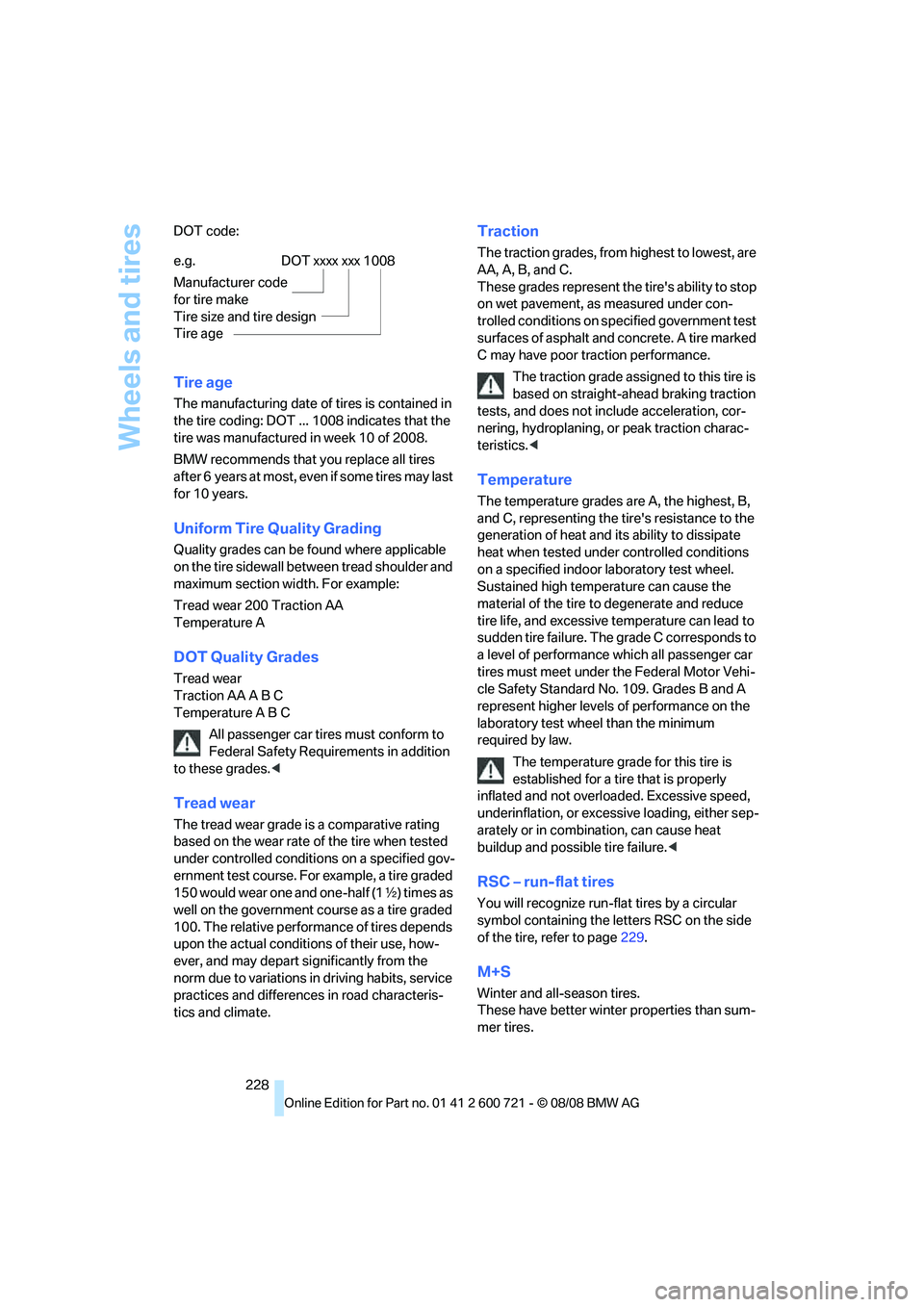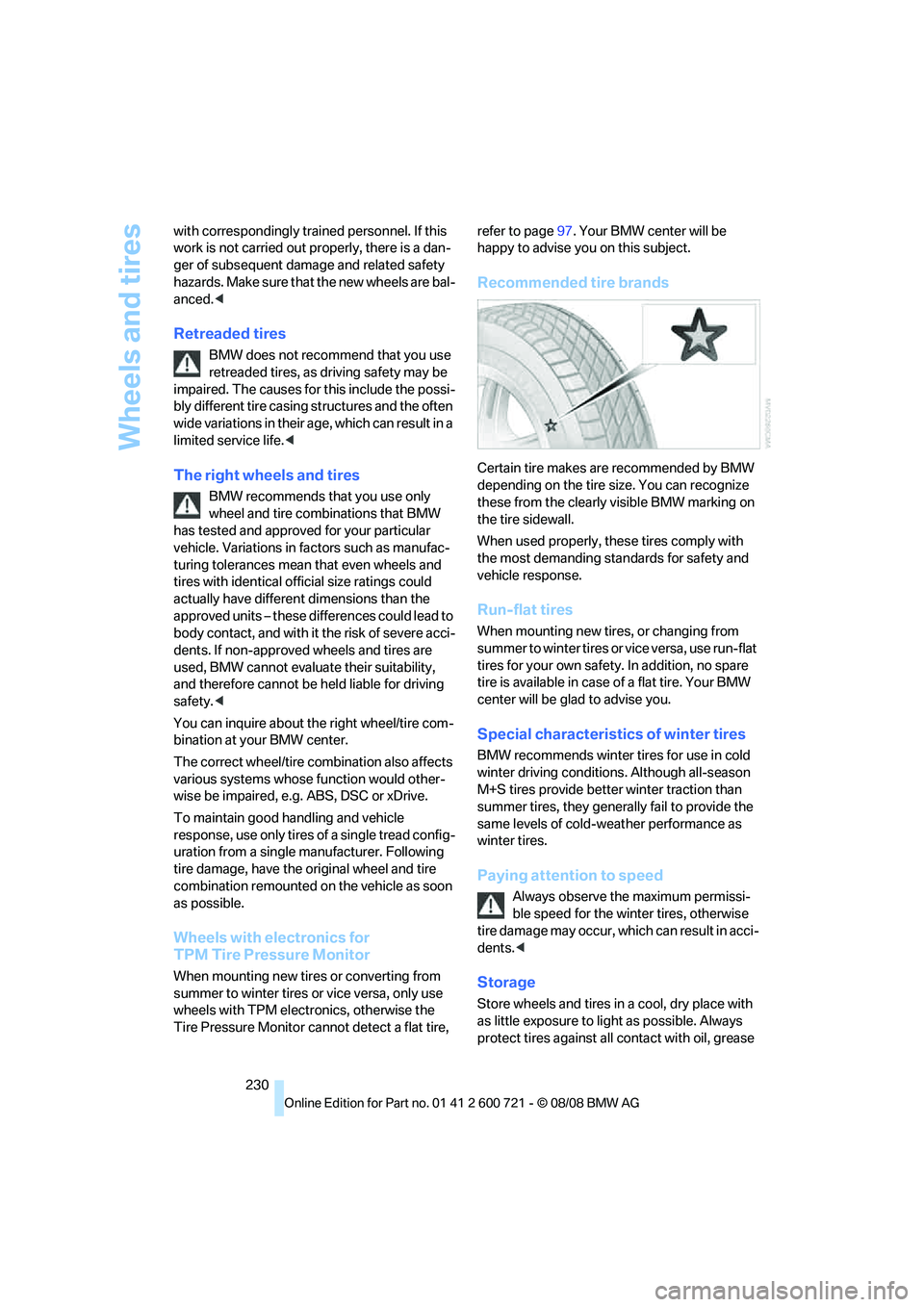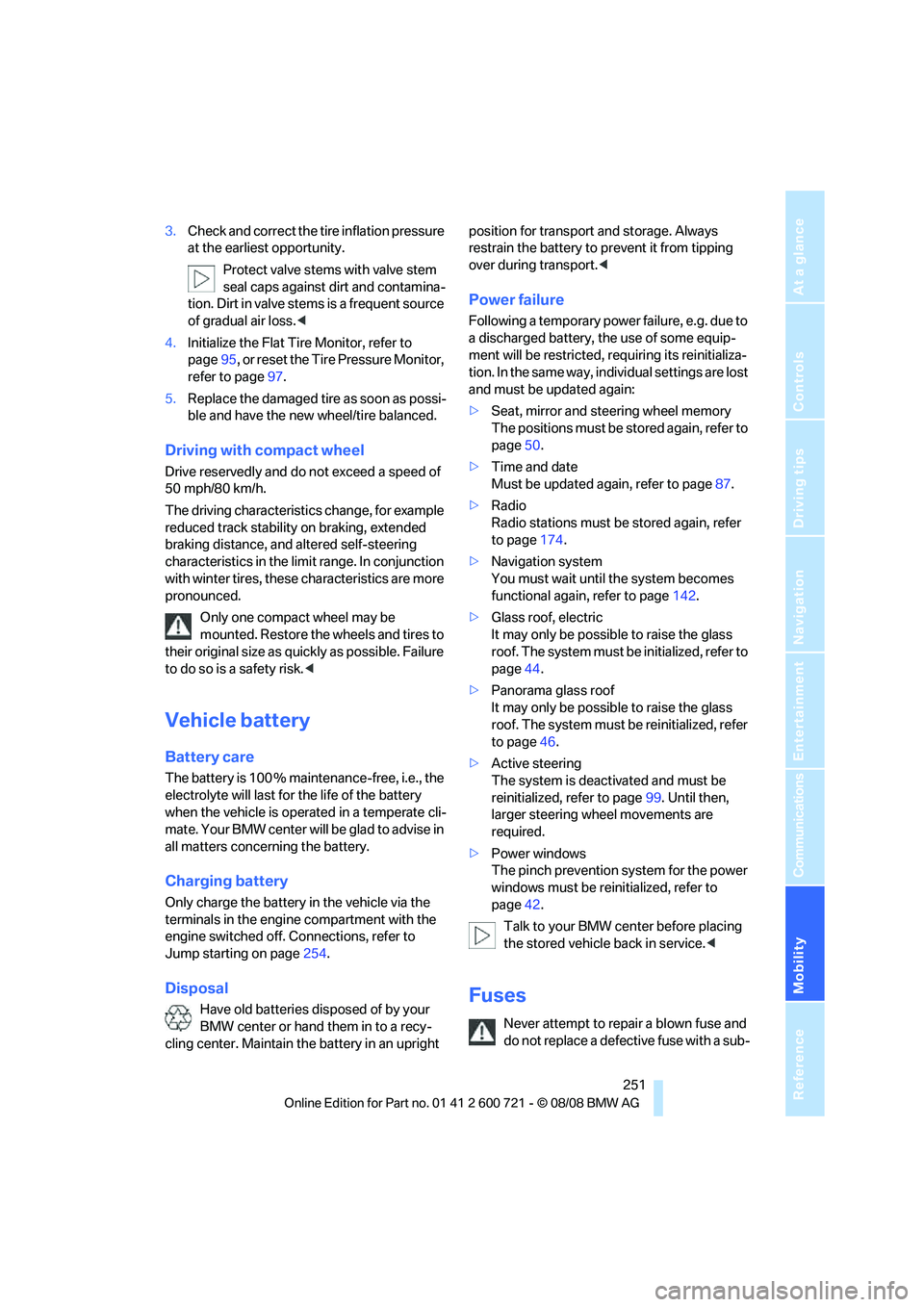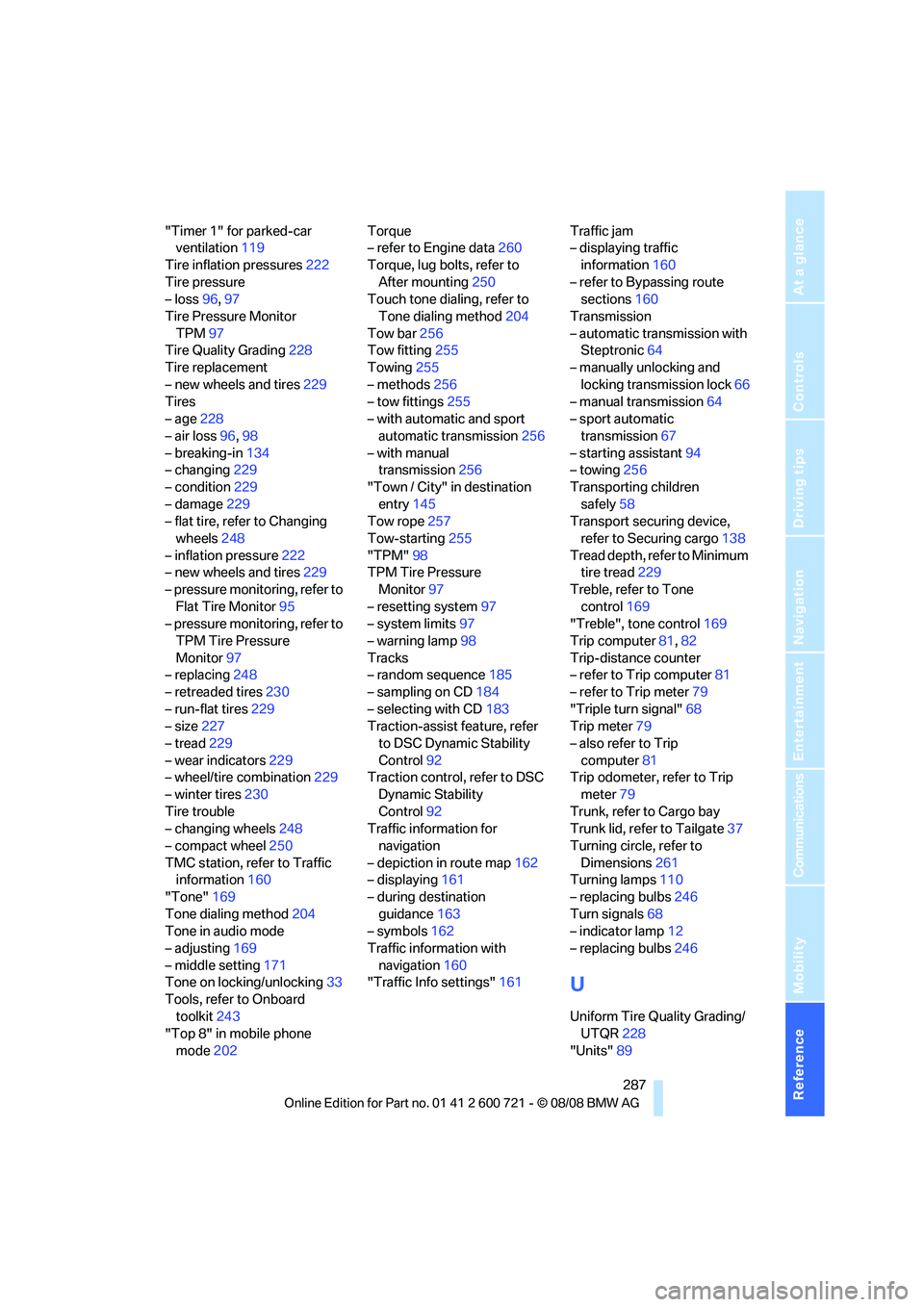2009 BMW 535I XDRIVE tire size
[x] Cancel search: tire sizePage 230 of 294

Wheels and tires
228 DOT code:
Tire age
The manufacturing date of tires is contained in
the tire coding: DOT ...1008 indicates that the
tire was manufactured in week 10 of 2008.
BMW recommends that you replace all tires
after 6 years at most, even if some tires may last
for 10 years.
Uniform Tire Quality Grading
Quality grades can be found where applicable
on the tire sidewall between tread shoulder and
maximum section width. For example:
Tread wear 200 Traction AA
Temperature A
DOT Quality Grades
Tread wear
Traction AA A B C
Temperature A B C
All passenger car tires must conform to
Federal Safety Requirements in addition
to these grades.<
Tread wear
The tread wear grade is a comparative rating
based on the wear rate of the tire when tested
under controlled conditions on a specified gov-
ernment test course. For example, a tire graded
150 would wear one and one-half (1γ) times as
well on the government course as a tire graded
100. The relative performance of tires depends
upon the actual conditions of their use, how-
ever, and may depart significantly from the
norm due to variations in driving habits, service
practices and differences in road characteris-
tics and climate.
Traction
The traction grades, from highest to lowest, are
AA, A, B, and C.
These grades represent the tire's ability to stop
on wet pavement, as measured under con-
trolled conditions on specified government test
surfaces of asphalt and concrete. A tire marked
C may have poor traction performance.
The traction grade assigned to this tire is
based on straight-ahead braking traction
tests, and does not include acceleration, cor-
nering, hydroplaning, or peak traction charac-
teristics.<
Temperature
The temperature grades are A, the highest, B,
and C, representing the tire's resistance to the
generation of heat and its ability to dissipate
heat when tested under controlled conditions
on a specified indoor laboratory test wheel.
Sustained high temperature can cause the
material of the tire to degenerate and reduce
tire life, and excessive temperature can lead to
sudden tire failure. The grade C corresponds to
a level of performance which all passenger car
tires must meet under the Federal Motor Vehi-
cle Safety Standard No. 109. Grades B and A
represent higher levels of performance on the
laboratory test wheel than the minimum
required by law.
The temperature grade for this tire is
established for a tire that is properly
inflated and not overloaded. Excessive speed,
underinflation, or excessive loading, either sep-
arately or in combination, can cause heat
buildup and possible tire failure.<
RSC – run-flat tires
You will recognize run-flat tires by a circular
symbol containing the letters RSC on the side
of the tire, refer to page229.
M+S
Winter and all-season tires.
These have better winter properties than sum-
mer tires. e.g.
Manufacturer code
for tire make
Tire size and tire design
Tire age
DOT xxxx xxx 1008
Page 232 of 294

Wheels and tires
230 with correspondingly trained personnel. If this
work is not carried out properly, there is a dan-
ger of subsequent damage and related safety
hazards. Make sure that the new wheels are bal-
anced.<
Retreaded tires
BMW does not recommend that you use
retreaded tires, as driving safety may be
impaired. The causes for this include the possi-
bly different tire casing structures and the often
wide variations in their age, which can result in a
limited service life.<
The right wheels and tires
BMW recommends that you use only
wheel and tire combinations that BMW
has tested and approved for your particular
vehicle. Variations in factors such as manufac-
turing tolerances mean that even wheels and
tires with identical official size ratings could
actually have different dimensions than the
approved units – these differences could lead to
body contact, and with it the risk of severe acci-
dents. If non-approved wheels and tires are
used, BMW cannot evaluate their suitability,
and therefore cannot be held liable for driving
safety.<
You can inquire about the right wheel/tire com-
bination at your BMW center.
The correct wheel/tire combination also affects
various systems whose function would other-
wise be impaired, e.g. ABS, DSC or xDrive.
To maintain good handling and vehicle
response, use only tires of a single tread config-
uration from a single manufacturer. Following
tire damage, have the original wheel and tire
combination remounted on the vehicle as soon
as possible.
Wheels with electronics for
TPM Tire Pressure Monitor
When mounting new tires or converting from
summer to winter tires or vice versa, only use
wheels with TPM electronics, otherwise the
Tire Pressure Monitor cannot detect a flat tire, refer to page97. Your BMW center will be
happy to advise you on this subject.
Recommended tire brands
Certain tire makes are recommended by BMW
depending on the tire size. You can recognize
these from the clearly visible BMW marking on
the tire sidewall.
When used properly, these tires comply with
the most demanding standards for safety and
vehicle response.
Run-flat tires
When mounting new tires, or changing from
s u m m e r t o w i n t e r t i r e s o r v i c e v e r s a , u s e r u n - f l a t
tires for your own safety. In addition, no spare
tire is available in case of a flat tire. Your BMW
center will be glad to advise you.
Special characteristics of winter tires
BMW recommends winter tires for use in cold
winter driving conditions. Although all-season
M+S tires provide better winter traction than
summer tires, they generally fail to provide the
same levels of cold-weather performance as
winter tires.
Paying attention to speed
Always observe the maximum permissi-
ble speed for the winter tires, otherwise
tire damage may occur, which can result in acci-
dents.<
Storage
Store wheels and tires in a cool, dry place with
as little exposure to light as possible. Always
protect tires against all contact with oil, grease
Page 253 of 294

Mobility
251Reference
At a glance
Controls
Driving tips
Communications
Navigation
Entertainment
3.Check and correct the tire inflation pressure
at the earliest opportunity.
Protect valve stems with valve stem
seal caps against dirt and contamina-
tion. Dirt in valve stems is a frequent source
of gradual air loss.<
4.Initialize the Flat Tire Monitor, refer to
page95, or reset the Tire Pressure Monitor,
refer to page97.
5.Replace the damaged tire as soon as possi-
ble and have the new wheel/tire balanced.
Driving with compact wheel
Drive reservedly and do not exceed a speed of
50 mph/80 km/h.
The driving characteristics change, for example
reduced track stability on braking, extended
braking distance, and altered self-steering
characteristics in the limit range. In conjunction
with winter tires, these characteristics are more
pronounced.
Only one compact wheel may be
mounted. Restore the wheels and tires to
their original size as quickly as possible. Failure
to do so is a safety risk.<
Vehicle battery
Battery care
The battery is 100 % maintenance-free, i.e., the
electrolyte will last for the life of the battery
when the vehicle is operated in a temperate cli-
mate. Your BMW center will be glad to advise in
all matters concerning the battery.
Charging battery
Only charge the battery in the vehicle via the
terminals in the engine compartment with the
engine switched off. Connections, refer to
Jump starting on page254.
Disposal
Have old batteries disposed of by your
BMW center or hand them in to a recy-
cling center. Maintain the battery in an upright position for transport and storage. Always
restrain the battery to prevent it from tipping
over during transport.<
Power failure
Following a temporary power failure, e.g. due to
a discharged battery, the use of some equip-
ment will be restricted, requiring its reinitializa-
tion. In the same way, individual settings are lost
and must be updated again:
>Seat, mirror and steering wheel memory
The positions must be stored again, refer to
page50.
>Time and date
Must be updated again, refer to page87.
>Radio
Radio stations must be stored again, refer
to page174.
>Navigation system
You must wait until the system becomes
functional again, refer to page142.
>Glass roof, electric
It may only be possible to raise the glass
roof. The system must be initialized, refer to
page44.
>Panorama glass roof
It may only be possible to raise the glass
roof. The system must be reinitialized, refer
to page46.
>Active steering
The system is deactivated and must be
reinitialized, refer to page99. Until then,
larger steering wheel movements are
required.
>Power windows
The pinch prevention system for the power
windows must be reinitialized, refer to
page42.
Talk to your BMW center before placing
the stored vehicle back in service.<
Fuses
Never attempt to repair a blown fuse and
do not replace a defective fuse with a sub-
Page 289 of 294

Reference 287
At a glance
Controls
Driving tips
Communications
Navigation
Entertainment
Mobility
"Timer 1" for parked-car
ventilation119
Tire inflation pressures222
Tire pressure
– loss96,97
Tire Pressure Monitor
TPM97
Tire Quality Grading228
Tire replacement
– new wheels and tires229
Tires
– age228
– air loss96,98
– breaking-in134
– changing229
– condition229
– damage229
– flat tire, refer to Changing
wheels248
– inflation pressure222
– new wheels and tires229
– pressure monitoring, refer to
Flat Tire Monitor95
– pressure monitoring, refer to
TPM Tire Pressure
Monitor97
– replacing248
– retreaded tires230
– run-flat tires229
– size227
– tread229
– wear indicators229
– wheel/tire combination229
– winter tires230
Tire trouble
– changing wheels248
– compact wheel250
TMC station, refer to Traffic
information160
"Tone"169
Tone dialing method204
Tone in audio mode
– adjusting169
– middle setting171
Tone on locking/unlocking33
Tools, refer to Onboard
toolkit243
"Top 8" in mobile phone
mode202Torque
– refer to Engine data260
Torque, lug bolts, refer to
After mounting250
Touch tone dialing, refer to
Tone dialing method204
Tow bar256
Tow fitting255
Towing255
– methods256
– tow fittings255
– with automatic and sport
automatic transmission256
– with manual
transmission256
"Town / City" in destination
entry145
Tow rope257
Tow-starting255
"TPM"98
TPM Tire Pressure
Monitor97
– resetting system97
– system limits97
– warning lamp98
Tracks
– random sequence185
– sampling on CD184
– selecting with CD183
Traction-assist feature, refer
to DSC Dynamic Stability
Control92
Traction control, refer to DSC
Dynamic Stability
Control92
Traffic information for
navigation
– depiction in route map162
– displaying161
– during destination
guidance163
– symbols162
Traffic information with
navigation160
"Traffic Info settings"161Traffic jam
– displaying traffic
information160
– refer to Bypassing route
sections160
Transmission
– automatic transmission with
Steptronic64
– manually unlocking and
locking transmission lock66
– manual transmission64
– sport automatic
transmission67
– starting assistant94
– towing256
Transporting children
safely58
Transport securing device,
refer to Securing cargo138
Tread depth, refer to Minimum
tire tread229
Treble, refer to Tone
control169
"Treble", tone control169
Trip computer81,82
Trip-distance counter
– refer to Trip computer81
– refer to Trip meter79
"Triple turn signal"68
Trip meter79
– also refer to Trip
computer81
Trip odometer, refer to Trip
meter79
Trunk, refer to Cargo bay
Trunk lid, refer to Tailgate37
Turning circle, refer to
Dimensions261
Turning lamps110
– replacing bulbs246
Turn signals68
– indicator lamp12
– replacing bulbs246
U
Uniform Tire Quality Grading/
UTQR228
"Units"89